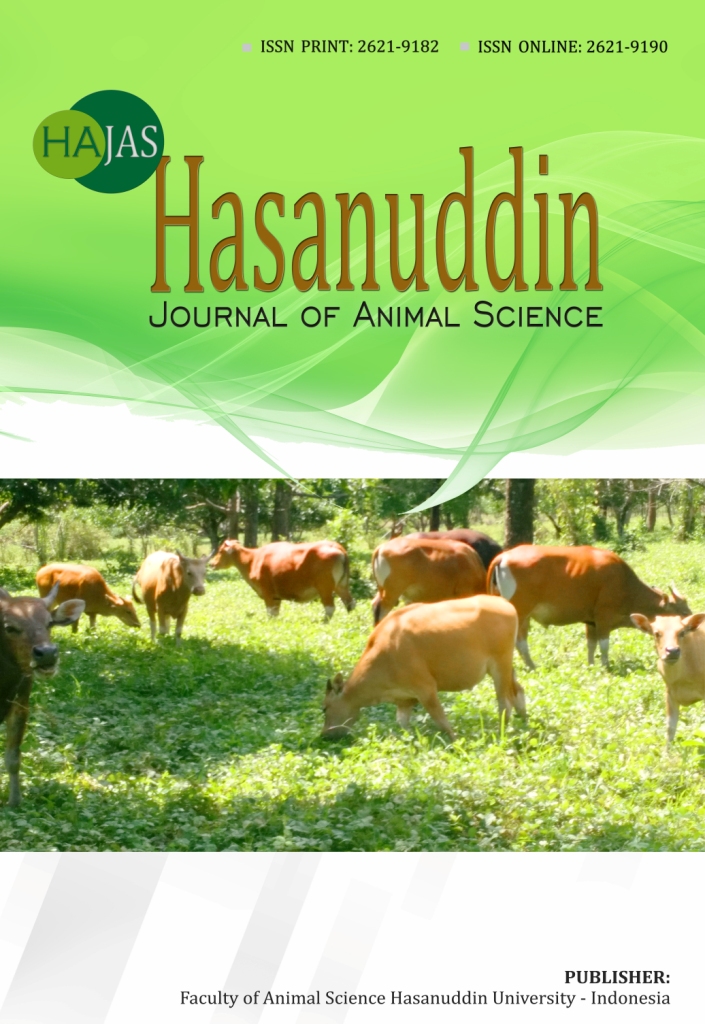Antioxidant Activities of Beef Sausage with Addttion of Kluwak (Pangium edule Reinw)
Keywords:
sausages, kluwak, flavonoids, antioxidants, and oxidation of lipid,Abstract
Oxidation is one of the important factors that affect the quality of meat products including sausages. To inhibit oxidation, ingredients need to be added in the process of making sausages which act as antioxidants. One plant that functions as a natural antioxidant is kluwak. Kluwak can be used to extend the shelf life. Kluwak 0 days and 40 days fermentation. Aside from being a preservative, kluwak seeds also contain antioxidant compounds and flavonoid groups. Antioxidant compounds that function as anti-cancer in kluwak seeds include vitamin C, iron ions, and Beta carotene which are the work of fermented kluwak seeds for 40 days. This study aimed to determine the effect of different types and levels of kluwak and their interactions on the physical characteristics and antioxidant activity of beef sausages during storage. This study uses two types of kluwak (0 days and fermentation 40 days), different levels and length of storage. Results of this study can increase antioxidant activity and reduce oxidation of lipid.
References
Alam, MN, Bristi, NJ and Rafiquzzaman, Md. (2013). Review on in vivo and in vitro methods of evaluation of antioxidant activity. Saudi Pharmaceutical Journal. 21: 143-152.
Burkill, IH (1935) A dictionary of the economic products of the Malay peninsula. Crown Agents, London, pp. 1653-1654
Cooper, JV, Suman, SP, Wiegand, BR, Schumacher, L. and Lorenzen, CL (2017). Light source color stability and lipid oxidation influences in steaks from low color beef stability Triceps brachii Muscle. Meat and Muscle Biology. 1: 149-156.
Davidek, J., J. Vellisek and J. Pokorny. 2004. Chemical change during food processing. Department of food chemistry and analysis. Chemical Technology Institute, New York. Diet Supleme. Trubus Agriwidya: Jakarta.
El-Ghorab, A., T. Shibamoto and M. Ozcan. 2007. Chemical composition and antioxidant activities of buds and leaves of capers (Capparis ovata Desf. Var. Canesencene) cultivated in Turkey. J. Essent. Oil Res. 19: 72-77
Estiasih, T. and Ahmadi. 2009. Food Processing Technology. Bumi Aksara, Jakarta.
Gordon MH. 1990. The Mechanism of In Vitro Antioxidant Activity. Inside: BJF Hudson (ed). Food Antioxidants. London: Elseviere Appl Sci.
Hudson, B. 1990. Food antioxidants. Elsevier Apllied Science, London
Idris, A. 2005. Essential Toxrienols for Health.
Kato, M., Inoue, T. and Nagamitsu, T. (1995),Pollination biology of Gnetum (Gnetaceae) in a lowland mixed dipterocarp forestin Sarawak, Am. J. Bot., 82, 862-868
Kochhar, SP, and Rossell, B., 1990, "Detection Estimation and Evaluation of Antioxidants in Food Systems, editor: BJF Hudson, Food Antioxidants, Elsevier Applied Science, London, 2. Miyake , T., and Shibamoto, S., 1997, "Antioxidant Activities of Natural Compounds Found in Plants", J.Agric.Food.Chem, 45, 1819-1822.
Noller, CR 1965. Chemistry of Organic Compounds. 3rd Ed. WB Sounders Company. Philadelphia.
Mapiye C, Aldai N, Turner T. D, Aalhus J. L, Rolland, D. C, Kramer JKG, The Labile Lipid Fraction of Meat: From Perceived Disease and Waste to Health and Opportunity, Meat Science., 2012, 92, 210–220.
Nurwantoro V et al. 2012. The value of pH, water content, and total Escherichia coli beef are marinated in garlic juice. A Food Techniques Application.1 (2): 20-22.
Padayatty S, Katz A, Wang Y, Eck P, Kwon O, Lee J, et al. Review of Vitamin C as Antioxidant: Evaluation of Its Role in Disease Prevention. J Am Coll Nutr. 2002 May 13; 22 (1): 18-35.
Pratt, DE, 1992, "Natural Antioxidants From Plant Materials", editors: MT Huang, CT Ho, and CY Lee, Phenolic Compounds in Food and Their Effects on Health, American Society, Washington DC, 5-6.
Rahmawati, D. 2009. Endophytic Microbes Solution for Cheap and Environmentally Friendly Medicinal Raw Materials. Press conference. Deputy director of the UI communications office.
Romlah, Tatiek. 1992. Theory and Practice of Guidance and Counseling. Malang: Malang State University
Singh, P., R. Shukla, B. Prakash, A. Kumar, S. Singh, PK Mishra and NK Dubey. 2010. Chemical profile, antifungal, antiaflatoxigenic and activity of citrus maxima burm antioxidant. and citrus sinensis (L.) osbeck essential oils and their cyclic monoterpene, DL-limonene. Food and Chemical Toxicology 48: 1734– 1740.
Soeparno. 2009. Meat science and technology. Gadjah Mada University Press. Yogyakarta.
Sun, Y. (1990), Free radicals, antioxidant enzymes, and carcinogenesis, Free Radic. Biol. Med., 8, 583-599
Suratmo, Free Material Radical Reaction, Faculty of Mathematics and Natural Sciences Universitas Brawijaya, Malang, 2012, 30
Sánchez A, Djenane D, Torrescano G, Beltrán J, RoncalÈs P. The effects of ascorbic acid, taurine, carnosine and rosemary powder on color and lipid stability of beef patties packaged in modified atmosphere. Meat Sci. 2001 May 22; 58 (4): 421-429
Widyasari, RAHE 2005. Technology of preservation of Mackerel (Rastreligerbranchyosoma) Fresh by using Natural Bioactive Ingredients of Picung Seed (Pangium edule Reinw.) Thesis. Postgraduate School of Bogor Agricultural University.
Windono, T., Budiono, R., Ivone, Valentina, S. and Saputro, Y., 2004, "Study of the Relationship between the Activity Structure of the Flavonoid Compound Free Radical Capability of 1,1-Diphenyl-2-Picrylhydrazyl (DPPH)", Artocarpus, Surabaya, 4 (2), 47-51











